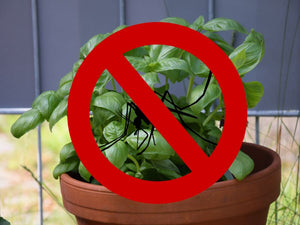How to Grow Valerian Root from Seed to Harvest
Medicinal herbsValerian (Valeriana officinalis), a perennial plant in the honeysuckle family, is most well known for the medicinal properties of its roots. Valerian root is a popular herb used as a sleep aid by many looking for a more natural solution to sleepless nights.

How to Grow, Harvest, and Use Valerian Root
Besides its use as a medicinal herb, valerian also has beautiful, vanilla-scented blossoms. Once it is established in a wildflower or cottage garden, it will grow for years. Its flowers attract pollinators, and its scent is loved by cats.

How to Grow Valerian from Seed
Valerian root can be started from seed and grown in your own healing garden. Seeds can be started indoors or directly sown outdoors.
Tips for fail-proof valerian seed germination
Cold stratification improves germination for valerian seeds. To cold stratify valerian seeds indoors, place them in the refrigerator for two weeks before starting seeds indoors.
Cold stratification of valerian seeds can also be accomplished through winter sowing. Plant seeds outdoors in late winter or fall, where they can go through a cold winter period and germinate in spring.
After cold stratifying, plant valerian seeds ½” deep.
Soil temperature of 60º to 70ºF is optimal for germination.
Keep seeds moist until they germinate, which can take 2 to 3 weeks.

Transplanting Valerian Seedlings Outdoors
Once valerian seedlings have true leaves and are several inches tall, they can be transplanted outdoors.
Wait until all danger of frost is passed and take time to harden off tender seedlings.
Transplant seedlings to a location with full sun or partial shade.
Space valerian seedlings 18” apart. Mature plants can grow 3 to 5 feet tall.

Growing Valerian in Your Medicinal Garden
Sun
Valerian can grow in full sun to partial shade. Too much shade can result in floppy stems under the weight of flowers.
Soil
Valerian plants prefer soil that is nutrient-rich and retains moisture without staying waterlogged.
Water
Keep valerian plants regularly watered. Plants won't grow well in drought conditions.
Pruning
Valerian is a vigorous self-sower. To prevent self-seeding, snip flower heads off valerian plants before they go to seed. Valerian flowers are very fragrant with a vanilla scent and can be used in cut flower arrangements.

Harvesting Valerian Root
The roots of the valerian plant are what you will commonly use for medicinal purposes. Valerian leaves, though less potent, can also be used.
Wait until the fall of the second year to harvest valerian roots. Cut off the flowering tops in the first year to allow the roots time to develop.
To harvest valerian roots, dig deep to get a whole root. Wash the roots and allow them to fully dry. While the flowers have a pleasant scent, the roots do not. So you may want to dry roots in a location where the smell won’t be a problem or use a fan and open windows. Store dried valerian roots in an airtight container away from sunlight.

Valerian Edible Uses
Valerian, a once common ingredient used in the Middle Ages, has fallen from popularity in the edible sense. While you probably won’t find Valerian served at your dinner table in the form of a soup or stew, the seeds can be eaten when lightly roasted.
Medicinal Uses of Valerian
Valerian root has been given much praise by those suffering from insomnia for its ability to help people fall asleep faster and stay asleep longer without residual drowsiness. Studies show that valerian becomes more effective when used regularly for two or more weeks. However, it can be habit-forming, so long-term use exceeding four weeks is not recommended.
The calming effect of valerian not only helps people fall and stay asleep, but it is also beneficial for those suffering from anxiety and panic attacks. When used in small doses, it has even been known to improve symptoms of depression and obsessive-compulsive disorder (OCD). However, higher doses of valerian can have the opposite effect. Additionally, the calming properties of valerian can help lessen the effects of nicotine withdrawal, aiding those who desire to quit smoking!
Valerian has a relaxing effect on the muscles of the body, which can help those with epilepsy or experiencing menstrual cramping. As an analgesic (pain reliever), valerian is an effective treatment for managing pain during menstruation. It also relaxes the blood vessels, helping to lower the blood pressure and pulse rate of those with hypertension.
The dosage amount of valerian will vary depending on the desired effect. A typical effective dose of valerian root tea is 2-3 grams or 1-1.5 teaspoons of dried root.
Warnings
Valerian can be habit-forming, and the long-term effects are unknown and still being studied. Large doses can have an opposite, negative effect on the body. Only use valerian when needed and in regular doses. Do not use it if pregnant, as its effects are still unknown.
Valerian Root Tea
Add 1 teaspoon of valerian root to 1 cup of near-boiling water. (Boiling water can degrade the active components of the root) Cover and steep for 10-15 minutes. Drink fresh for the best results.
Valerian root is easy to start growing from seed. This adaptable plant can be grown for its medicinal value as well as its beautiful and fragrant flowers. As a perennial medicinal plant, it will be a welcome part of a wildflower or cottage garden, where pollinators will enjoy it for years to come.
Written by Ashley Clark
Found this information helpful? Share it with a gardening friend!










Leave a comment